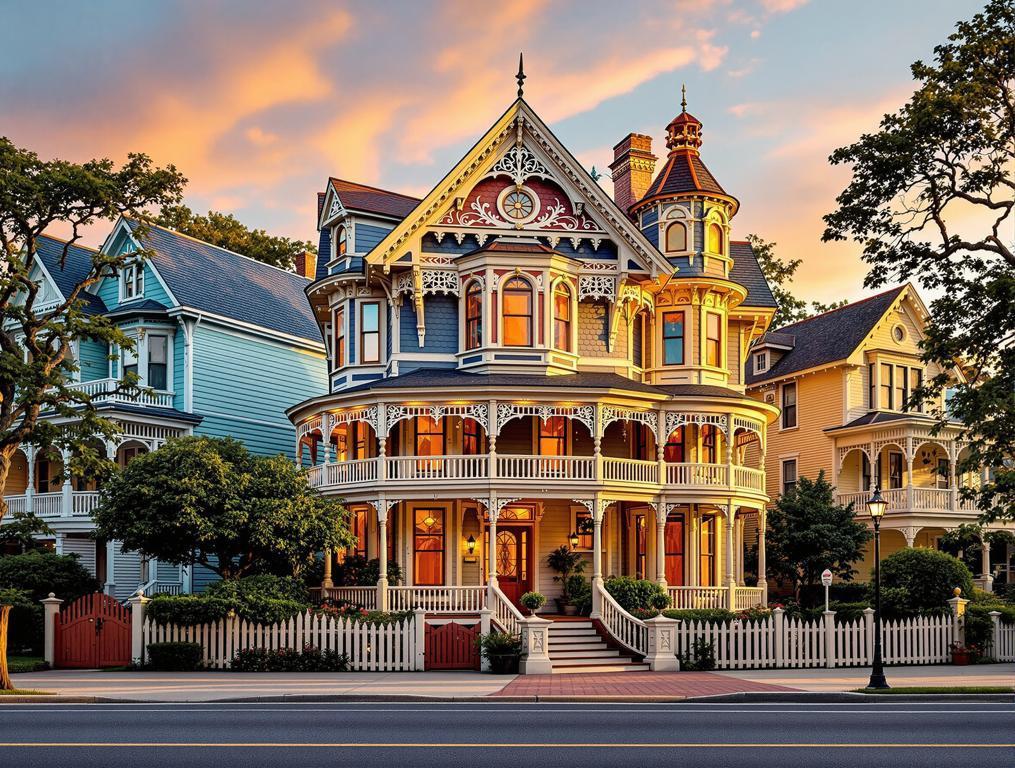The bells of the Great Auditorium chime in the distance as I step from my car onto Ocean Grove’s Main Avenue. At first glance, it looks like a Victorian postcard come to life – ornate gingerbread-trimmed cottages lined up like pastel candies along narrow streets. Just 60 miles south of Manhattan and mere steps from the Atlantic, I’ve stumbled upon America’s best-preserved religious resort, founded 156 years ago in 1869. While throngs of tourists crowd neighboring Asbury Park’s famous boardwalk just a mile north, Ocean Grove’s 3,076 residents quietly maintain what locals still call “God’s Square Mile.”
This 156-year-old religious resort was founded as “God’s Square Mile” in 1869
Ocean Grove began as a summer camp meeting site for Methodists seeking spiritual renewal by the sea. The town’s perfectly preserved grid of streets, centered around a grand wooden auditorium, reveals its religious origins.
The Camp Meeting Association, formed in 1869, still owns every inch of land here. You don’t buy property in Ocean Grove – you lease the land beneath your home, a tradition maintained for over a century and a half.
Unlike many historic American towns that preserve just a few landmark buildings, Ocean Grove’s entire 0.85 square mile area remains remarkably intact. America’s small towns often guard our most fascinating historical narratives, from Stockholm, Wisconsin’s 200-year-old Dakota legend to Ocean Grove’s religious revival stories.
Ocean Grove hides America’s largest collection of Victorian seaside architecture in less than one square mile
Walking these streets feels like stepping through a time portal. Over 600 Victorian structures stand shoulder to shoulder, their intricate woodwork and wraparound porches telling stories of 19th-century craftsmen.
While Port Townsend on the opposite coast preserves more Victorian buildings than Charleston, Ocean Grove offers the East Coast’s densest collection of these architectural treasures. Ocean Grove’s Victorian preservation rivals other Jersey Shore landmarks like Lucy the Elephant, which similarly dates to the late 19th century.
“People visit Asbury Park for the music and nightlife, but they come here to step back in time. When the morning light hits these houses just right, you can almost hear the rustling of Victorian dresses on the boardwalk.”
In July, while thousands of visitors crowd Asbury Park’s beaches, Ocean Grove maintains its tranquil rhythm. Families gather on front porches, concerts echo from the Great Auditorium, and the unique absence of commercial chains preserves its 19th-century character.
The Great Auditorium: A wooden marvel that seats 6,000 without a single interior column
The town’s crown jewel stands at its center – a vast wooden structure built in 1894 that can seat 6,000 people and still hosts regular concerts and religious services. The acoustics are so perfect that performers need no amplification.
The camp meeting’s 156-year continuous operation under the same organization echoes rare examples of historical continuity like Josselin, France, where the same family has maintained ownership for centuries.
I watch as a symphony orchestra rehearses inside, musicians marveling at how their instruments sound in this acoustic masterpiece. “It’s like playing inside a giant wooden instrument,” one cellist tells me during a break.
Why Ocean Grove’s unique tent community is a living historic treasure
Perhaps most remarkable are the 114 canvas tents that appear each summer around the Auditorium. These aren’t temporary camping structures but seasonal homes with canvas tops and permanent wooden platforms.
July transforms small American towns in distinctive ways, whether through Crested Butte’s wildflower explosion or Ocean Grove’s tent community revival. Some families have occupied the same tent for five generations, creating a summer community that bridges three centuries.
These tents, with their striped awnings and carefully tended flower boxes, create a time capsule of American summer traditions. Erected each May and dismantled in September, they represent one of America’s most unusual living historic traditions.
What the guidebooks won’t tell you about visiting Ocean Grove
For the best experience, arrive on a Thursday or Friday morning when parking on Main Avenue is plentiful. The town offers free beach access before 9am, a rarity on the Jersey Shore.
Don’t miss the Historical Society Museum on Pitman Avenue, where locals share stories about tent life and the Great Auditorium’s famous visitors, from presidents to Enrico Caruso.
The 56th Annual House Tour happens in late July, offering rare access to private Victorian homes. Book tickets early – they sell out weeks in advance.
As evening falls and I walk back to my car, Ocean Grove feels like a place that exists outside normal American time. While my seven-year-old daughter Emma would adore the ice cream parlor with its marble counters and brass fixtures, my wife Sarah would spend hours photographing the intricate “gingerbread” trim that makes each house unique. Like a Victorian-era snow globe settled by the Atlantic, Ocean Grove preserves a piece of American spiritual and architectural heritage that most Jersey Shore visitors never discover. And somehow, that makes finding it all the more rewarding.
